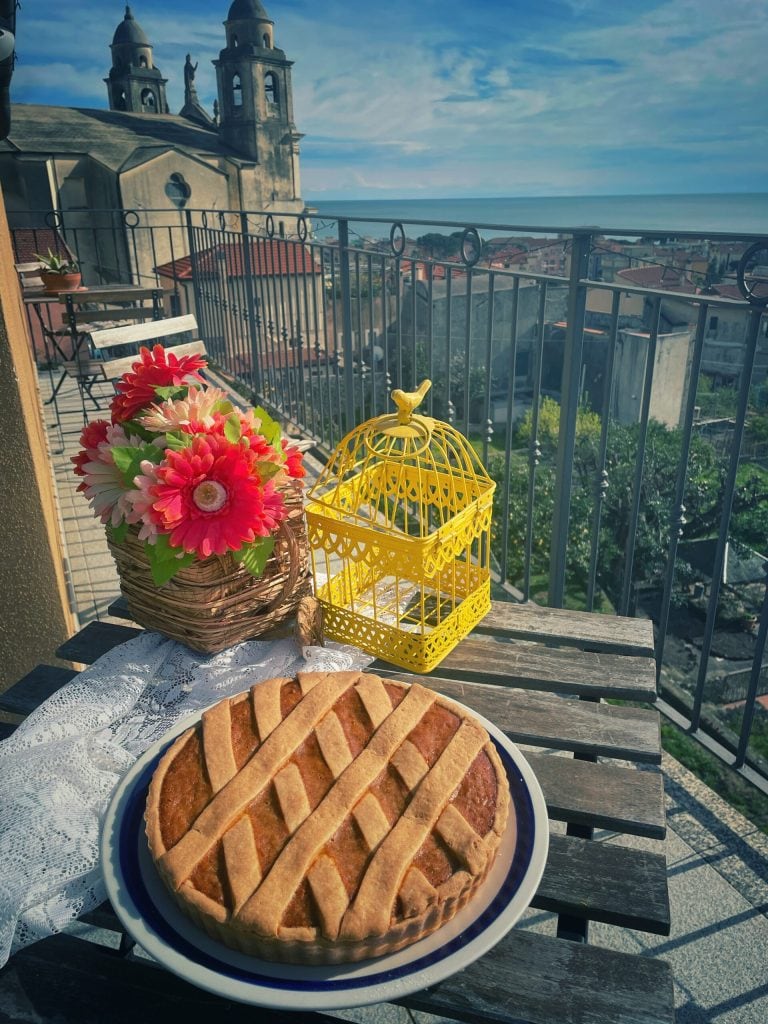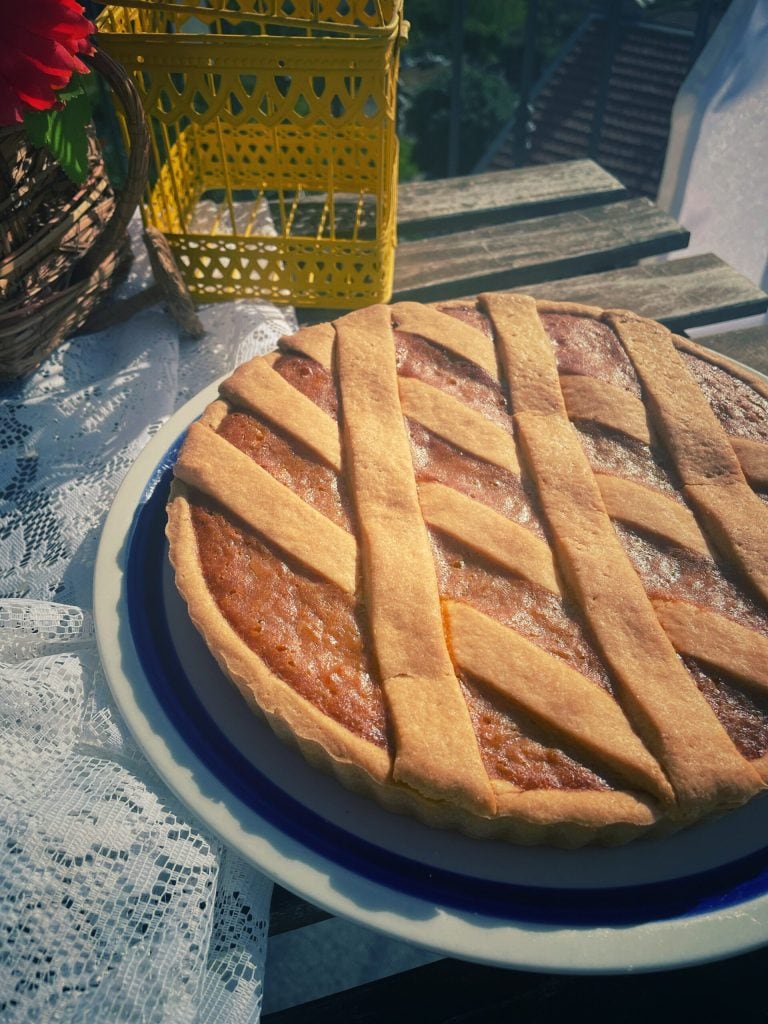I made the Gluten-Free and Lactose-Free Rice Pastiera during the Gluten-Free Cooking Course organized by Sissi from Golosi senza glutine, held on March 28, 29, and 30, 2025, at the B&B “A carubba du bungiurno” in Borgio Verezzi (SV).
The rice pastiera is a variation of the more famous Neapolitan pastiera, which traditionally uses cooked wheat as its main ingredient.
The rice version is typical of some areas in southern Italy, such as Campania and Calabria, and is prepared similarly to the traditional pastiera, but with rice replacing the cooked wheat.
Although less known, it is still associated with the Easter tradition, symbolizing rebirth and prosperity.
Like the Neapolitan pastiera, the rice pastiera has ancient roots and is said to date back to the time of the Romans, who prepared a similar cake with wheat, a symbol of fertility and spring.
Over time, the recipe evolved, and the rice version took hold in areas where rice was more readily available than cooked wheat.
It features a base of cooked rice mixed with a cream of ricotta, eggs, sugar, and flavored with orange blossom or candied fruits.
The crust is made with a shortcrust pastry similar to that of the traditional pastiera, with lard being the most faithful to the Neapolitan tradition, making the shortcrust pastry more crumbly.
The following recipe is for the Gluten-Free and Lactose-Free Rice Pastiera, made with a mix of gluten-free flours, delactosed butter, milk, and ricotta.
For the original Neapolitan Pastiera recipe, see below.

- Difficulty: Medium
- Cost: Medium
- Rest time: 12 Hours
- Preparation time: 15 Minutes
- Portions: 6 People
- Cooking methods: Stovetop, Oven
- Cuisine: Italian
- Seasonality: Easter, Spring
Ingredients
- 6.17 oz lactose-free ricotta
- 3/4 cup granulated sugar
- 2 eggs
- to taste cinnamon
- 2 tbsps orange blossom flavor
- 1.41 oz mixed candied fruits
- 1/4 cup Carnaroli rice
- 1 1/4 cups lactose-free milk (or plant-based)
- 1 orange (zest)
- 1 g lemon (zest)
- 1 tbsp lactose-free butter
- 14.11 oz gluten-free flour mix (for shortcrust pastry)
- 7.05 oz lactose-free butter
- 3/4 cup granulated sugar
- 2 eggs
Tools
- 1 Baking Pan 9.5 inches
Steps
Drain and sift the ricotta.
Mix all the ingredients for the “ricotta cream” and leave in the fridge overnight.
For the rice cream: cook the rice in the milk with all the other ingredients for about 15/20 minutes until absorbed.
Let cool before adding to the ricotta cream.
Knead the flour with the butter.
Add the sugar until you get a sandy texture.
Add the eggs until you get a smooth, homogeneous, and elastic dough.
Cover with plastic wrap and let stabilize in the fridge for at least 30 minutes before using.
Combine the ricotta cream with the rice cream.
Cover a cake pan with the shortcrust pastry and fill with the cream, cover with strips of shortcrust pastry (7) and bake at 340°F static for about 40 minutes until golden brown.
At the agriturismo and B&B A Carubba du Bungiurnu, you will be welcomed by Valentina and her partner Marco, growers of a beautiful garden above Verezzi, and olive growers.
A few years ago, they planted about thirty apricot trees of an indigenous variety, the Valleggia.
You can taste their products during breakfast, the summertime “Farmer’s Lunches,” or at the various events they organize.
For information and reservations: +39 338 53 43 664 bungiurnu@gmail.com www.bungiurnu.it
For information and reservations: +39 338 53 43 664 bungiurnu@gmail.com www.bungiurnu.it
To participate in the gluten-free cooking courses, both in-person and online with Golosi senza glutine, you can contact: www.golosisenzaglutine.com info@golosisenzaglutine.com +393398213062 Sissi
FAQ (Questions and Answers)
What is the traditional Neapolitan pastiera recipe?
Ingredients for the traditional shortcrust pastry for Neapolitan pastiera (with lard)
Flour 00: 300 g
Lard: 150 g
Sugar: 100 g
Eggs: 2 whole
Grated lemon zest
Salt
Procedure
In a bowl, mix the flour and salt.
Add the cold lard cut into pieces and start working it with your fingertips until you get a sandy texture.
Add the sugar, grated lemon zest, and eggs. Work the dough quickly, trying not to heat it too much.
Continue kneading until you get a homogeneous mixture. If the dough is too soft, you can add a little more flour.
Form a ball with the dough, wrap it in plastic wrap, and let it rest in the fridge for at least 30 minutes.
After resting, roll out the dough on a floured surface, aiming for a thickness of about 1/8 inch.
Use the dough to line a round cake pan, leaving a high edge of about 3/4 inch. You can cover the filling with 7 strips to create the traditional lattice on top.
Ingredients for the traditional Neapolitan Pastiera filling:
Cooked wheat: 300 g
Sheep ricotta: 500 g
Sugar: 300 g
Eggs: 5
Orange blossom water: 2 tablespoons (you can adjust the amount to your taste, but it should not overpower)
Vanilla: 1 pod or 1 teaspoon of extract (optional, but adds a good aroma)
Grated lemon zest: 1 lemon
Cinnamon powder: a pinch (optional)
Butter: 30 g
Procedure:
If you are not using pre-cooked wheat, you need to cook it first. To do this, rinse the wheat under running water, then cook it in plenty of salted water for about 40 minutes or until tender.
Once ready, drain it and let it cool.
If the ricotta is too watery, drain it well or squeeze it with a clean cloth to achieve a more compact consistency. Then place it in a large bowl.
Add sugar, vanilla, lemon zest, cinnamon (if desired), orange blossom water, and orange blossoms (if using) to the ricotta. Mix well until you get a creamy mixture.
Slightly beat the eggs and incorporate them into the ricotta mixture. Once the eggs are well blended, add the cooked wheat and mix gently.
Melt the butter and add it to the mixture. This will make the filling richer and softer. Let the filling rest for about 30 minutes before using it to allow all the flavors to blend well.
Pour the prepared filling over the shortcrust pastry base, create the lattice.
Bake the pastiera in a preheated oven at 356°F for about 60-70 minutes.
Let it cool completely before serving; the pastiera is even better the next day.What is the history of the traditional Neapolitan pastiera?
The history of the Pastiera dates back centuries, and various sources tell different versions.
One of the most fascinating legends concerns its origin in ancient Greek Naples.
It is said that the pastiera was originally prepared as an offering to pagan deities.
In particular, some say that Neapolitan women prepared a dessert to celebrate the reopening of the agricultural season, celebrating the fertility of the land and the return of spring.
Another version of the story pertains to the medieval period and the Church.
In fact, pastiera seems to have been created as an Easter dessert to celebrate the resurrection of Christ.
Some historians argue that the recipe was “blessed” by monks, who prepared it with symbolic ingredients to represent different aspects of Jesus’ sacrifice and rebirth.
The ricotta (symbolizing purity), eggs (rebirth and life), and cooked wheat (representing passion and sacrifice) are all ingredients that are part of religious symbolism.
It was traditionally prepared on Holy Saturday, in preparation for Easter Sunday, and its presence on Neapolitan tables was essential for celebrating the feast.Is it true that there should be 7 strips of shortcrust pastry on top?
Yes, there is a tradition that wants seven strips of shortcrust pastry arranged on the surface of the pastiera.
The seven strips are not only an aesthetic element, but also have symbolic meaning.
The strips represent the seven days of creation (according to the biblical account of Genesis) or, according to some interpretations, they might also symbolize the seven sorrows of the Madonna.

